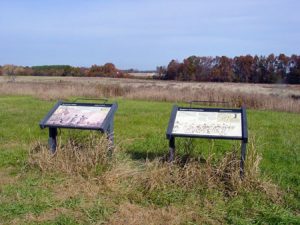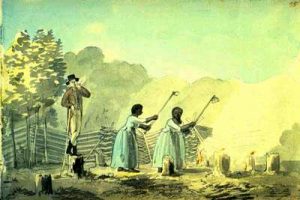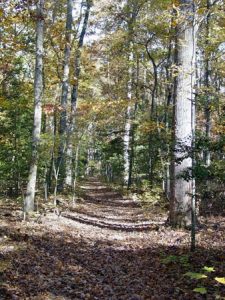Bernard Slave Cabins
 A new article by guest author Michael Aubrecht
A new article by guest author Michael Aubrecht
One of the more overlooked spots on the Fredericksburg National Battlefield is the Bernard Slave Cabins. This area was the homestead of a number of enslaved African-Americans and a focal point of the fighting that took place near Prospect Hill and the Slaughter Pen Farm. Today the site is accessible via the Bernard Cabins Trail. According to the NMPS website:

The NMPS tabletop marker that was erected on the site states: “On this knoll stood Bernard’s Cabins, a small community that in 1860 was home to about three dozen slaves. The complex consisted of three two-room cabins, a stone-lined well, and perhaps two additional buildings. This was only one of several such clusters of slave housing scattered across the 1,800-acre ‘Mannsfield’ estate. The men and women who lived here helped power the most prosperous plantation in the Fredericksburg area. Arthur Bernard’s plantation house, ‘Mannsfield’ (1766), stood about a mile east of here (it burned in 1863). During the 1862 Battle of Fredericksburg it served as headquarters for three top Union generals – W.B. Franklin, J.F. Reynolds, and W.F. Smith.”

NMPS historian Frank O ‘Reilly describes the significance of the Bernard Slave Cabins grounds in his book “The Fredericksburg Campaign: Winter War on the Rappahannock.” These small cottage-like buildings presented a potential problem for Confederate Gen. Thomas “Stonewall” Jackson’s artillerists who were forward deployed and attempting to prepare a cross-fire in anticipation of the Federal’s advancement towards Prospect Hill. He writes:
Crutchfield offset the problem somewhat by Captain Greenlee Davidson’s small battalion of guns at the Bernard Slave Cabins to cover Brockenbrough’s left rear. Crutchfield believed that an attack against Brockenbrough’s battalion would expose its flank to a raking oblique fire from Davidson’s guns. Davidson used elements of three batteries with a combination of six 3-inch rifles, two Napoleons, and one light 6-pounder. The artillerist posted Captain William H. Caskie’s Hampden (Virginia) Artillery with another section of Ed Marye’s Fredericksburg Artillery and Lieutenant Charles W. Statham’s Lee (Virginia) Artillery. The batteries unlimbered behind a rise capped by Bernard’s Cabins, three hundred yards behind Brockenbrough, and a thousand yards to R. Lindsay Walker’s left. Some of Marye’s Fredericksburg Artillery fought within sight of their homes. The gunners tore down the Bernard Cabins to clear their field of fire.

On the morning of Dec. 13, 1862, Union skirmishers crept forward through the mist-shrouded fields and began shooting at Brockenbrough’s exposed gunners. When Lane’s men were unable to drive them away, Brockenbrough opened on the pesky Union riflemen with canister large cylinders filled with dozens of marble-sized iron balls that had the effect of a giant shotgun blast. Brockenbrough’s guns drew the fire of Union artillery batteries on the plain ahead, and soon the Confederate guns were under intense fire from enemy sharpshooters and cannon alike.
The slave cabins and a small pine grove had stood between Davidson and his Yankee assailants, but no more. By the time he stopped shooting, the cabins were in ruins and the grove had been reduced to kindling. At Bernard’s Cabins, Union shot ignited one of Davidson’s ammunition chests, causing a terrific explosion. Fifteen of 20 shells caught fire and exploded, blackening the ground and stampeding the battery horses. One shell cut a Confederate gunner in two and threw his blackened clothing into a nearby tree; another took off the leg of an officer just above the knee. At one gun alone, five artillerists were injured. Jackson witnessed the vigor of the Union response and wisely cancelled the attack. South of town, at least, the killing was over.
Today, the Bernard Cabins Trail provides one of the most peaceful and enjoyable nature walks on the whole Fredericksburg Battlefield proper. Unfortunately, the cabins themselves are no longer standing and one has to depend entirely on their imagination to envision what this small slave community looked like. Perhaps in the future, either through traditional building reconstruction or virtual 3D-modeling technology, the Bernard Slave Cabins will be resurrected again. Until then, I highly recommend that visitor’s take a moment during their tour to leave the “main drag” of Lee Drive and hike the half a mile down to this unique and important site.
Sources:
O ‘Reilly, Frank, The Fredericksburg Campaign: Winter War on the Rappahannock (LSU Press; 1st edition, April 1, 2006)
Fredericksburg/Spotsylvania National Military Park website: https://www.nps.gov/frsp/index.htm
Historical Marker Database: https://www.hmdb.org/marker.asp?marker=7973
The Fredericksburg area is so full of interesting items to see. There is the Amtrak train running through, beautiful shops and brewery spots to visit and museums. The area is so full of history and nature. I enjoy visiting Fredericksburg very much.